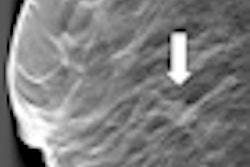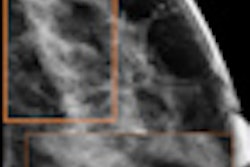In one of the first large-scale studies of its kind, Norwegian researchers have found that digital breast tomosynthesis (DBT) in combination with conventional digital mammography detects 40% more invasive cancers and decreases false-positive rates by 15%.
Dr. Per Skaane, PhD, of the University of Oslo, and colleagues used data from the Oslo Breast Cancer Screening Trial (conducted under the Norwegian Breast Cancer Screening Program) to perform an interim analysis of results from 12,631 exams interpreted using mammography alone and mammography plus tomosynthesis from November 2010 to December 2011. The study was published online January 7 ahead of print in Radiology.
"Tomosynthesis studies to date have focused primarily on the potential benefit of reducing false-positive interpretations and were performed in experimental settings," Skaane and colleagues wrote. "In this large-scale prospective study, we investigated the potential benefits and limitations of tomosynthesis, if any, in a population-based mammographic screening program."
The group assessed cancer detection rates, false-positive rates before arbitration (i.e., a consensus reconciling of reading radiologists' differing exam scores), positive predictive values for women recalled after arbitration, and the type of cancers detected.
Craniocaudal and mediolateral oblique views were taken of each breast with digital mammography and tomosynthesis by using a commercially available system (Selenia Dimensions, Hologic) with single-breast compression per view, Skaane's team wrote. Additional time required for tomosynthesis images was about 10 seconds per view; radiation dose levels for mammography plus tomosynthesis combined were approximately twice those for mammography alone.
Eight radiologists participated in the study, each rating the exams on a five-point scale. If a reader recorded a positive score (from 2, meaning probably benign, to 5, meaning highly suggestive of malignancy), the case went to discussion by at least two radiologists who came to consensus about whether to dismiss the initially suspected findings or invite the woman for further workup.
Skaane's group determined the following:
- Twenty-five additional invasive cancers were detected with mammography plus tomosynthesis -- a 40% increase.
- Detection rates, including those for invasive and in situ cancers, were 6.1 per 1,000 examinations for mammography alone and eight per 1,000 examinations for mammography plus tomosynthesis -- a 27% increase.
- False-positive rates before arbitration were 61.1 per 1,000 examinations with mammography alone and 53.1 per 1,000 examinations with mammography plus tomosynthesis -- a 15% decrease.
- After arbitration, positive predictive values for recalled patients with cancers verified later were comparable (29.1% with mammography alone and 28.5% with mammography plus tomosynthesis).
- Mean interpretation time was 45 seconds for mammography alone and 91 seconds for mammography plus tomosynthesis.
But is tomosynthesis simply detecting smaller cancers that might never harm the patient if left untreated, a phenomenon known as overdiagnosis? Not really, according to Skaane and colleagues.
"We believe that many of the additional abnormal findings detected with mammography plus tomosynthesis in our study are the very types of cancers one would hope to detect early and treat," the team wrote. "Perhaps our most important observation is that with the mammography-plus-tomosynthesis arm, the actual benefit, in terms of possibly improving outcome owing to earlier detection, may be larger than merely the difference in the total count or number of detected cancers."
More studies need to be done before tomosynthesis can be used in organized screening programs, according to Skaane.
"[Our study] was an interim analysis," Skaane told AuntMinnie.com via email. The Oslo Breast Cancer Screening Trial "has four arms -- one of which includes synthetic 2D images -- but this analysis evaluated only two. If these results also can be proved for the other two arms, there will be great impact on future mammography screening, due to the significantly higher cancer detection rate."
|
Study disclosures Hologic provided tomosynthesis equipment and financial support for additional interpretations. Co-authors Loren Niklason, PhD, and David Gur, ScD, are Hologic employees. |




















